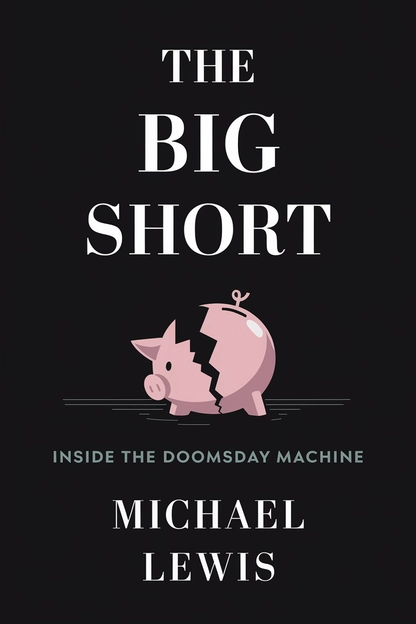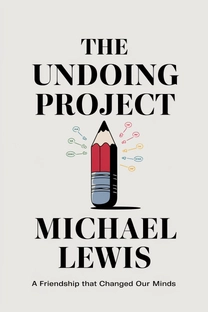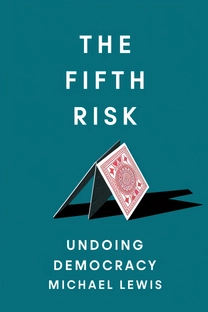
The Big Short
Inside the Doomsday Machine
by Michael Lewis
Brief overview
This book reveals how a group of unconventional thinkers spotted the looming subprime mortgage crisis before nearly anyone else. By following their journeys, you’ll uncover how complicated financial products played a pivotal role in the 2008 financial meltdown, leaving you with a deeper understanding of how greed, misjudged risk, and mistrust helped break the global economy.
Hooking Introduction
Imagine waking up one day to discover that a handful of outsiders had foreseen the near-collapse of the global financial system—yet few listened. That’s the startling reality at the heart of this story. It begins with people who dared to question the most accepted norms on Wall Street and glimpsed a financial house of cards looming on the horizon.
They weren’t typical bankers or analysts. Some were quirky hedge fund managers, others were oddball traders. All shared the uncommon ability to connect dots most professionals overlooked. Their suspicions concentrated on one market no one else seemed worried about—subprime mortgages.
In this introduction, we’ll see why their theories seemed far-fetched at first—yet ultimately proved correct. And we’ll set the stage for a deeper dive into the complicated instruments that made ordinary home loans the linchpin of a global crisis.
The Hedge Fund Mavericks
The story truly takes off when we meet several outsiders who felt uneasy about the rapidly ballooning mortgage market. They weren’t your standard Wall Street heroes; they were skeptics who shared a streak of defiance. One was a man driven by data and disinterested in social charms; others had made leaps from unrelated fields into finance, bringing fresh eyes and a refusal to accept old assumptions.
These contrarians approached mortgages differently. Rather than trust rating agencies or boilerplate research, they sifted through thousands of pages of mortgage bond details themselves. What they found was unsettling: an entire spectrum of ultra-risky loans hidden beneath layers of shiny packaging.
They questioned why banks kept promoting subprime mortgages—loans so shaky their borrowers were often stretched beyond reason. Conventional wisdom insisted home prices never go down nationwide. Our mavericks begged to differ. They smelled opportunity in the possibility of collapse—yet no one else wanted to hear it.
What is The Big Short about?
The Big Short: Inside the Doomsday Machine offers an in-depth look at the subprime mortgage meltdown that triggered the 2008 global financial crisis. In it, Michael Lewis tracks a handful of unconventional investors who saw the collapse coming before everyone else. This perspective highlights their cunning analysis and skepticism towards flawed rating systems and overly optimistic lending practices that dominated Wall Street.
Their journeys reveal how complex financial instruments, misjudged risks, and a mania for profit combined to rock the international economy. As readers follow these analytical outliers, they gain valuable insight into how quick thinking, resilience, and the will to challenge mainstream confidence can uncover lurking market dangers. By shining a light on these experiences, The Big Short underscores the importance of informed vigilance when navigating global finance.
Review of The Big Short
One standout strength of The Big Short is how it explains intricate financial details with surprising clarity. Readers get a front-row seat to the formation of exotic products like credit default swaps and collateralized debt obligations, learning how they contributed to one of the most severe economic downturns in history. By blending financial jargon with direct storytelling, Michael Lewis provides the background needed to interpret the crisis and highlights how hidden risks can remain overlooked if no one asks tough questions.
This book is perfect for both finance professionals and curious readers eager to understand what caused the meltdown. The language is approachable, yet detailed enough to offer real-world lessons on risk management and system-wide blind spots. The stories of underdogs who spotted danger in subprime lending before it toppled the market will resonate with anyone interested in challenging consensus thinking. For those seeking a compelling account of how a crisis unfolds—and the mavericks who saw it coming—The Big Short is a highly worthwhile read.
Who should read The Big Short?
- Finance professionals seeking deeper insight into market vulnerabilities
- Business and economics students wanting a gripping real-world case study
- Investors exploring risk management strategies and contrarian thinking
- Readers fascinated by the interplay of human behavior, greed, and markets
About the author
Book summaries like The Big Short
Why readers love Mindleap
10-Minute Book Insights
Get the core ideas from the world's best books in just 10 minutes of reading or listening.
Curated For You
Discover your next favorite book with personalized recommendations based on your interests.
AI Book ExpertNew
Chat with our AI to help find the best book for you and your goals.
Reviews of MindLeap
Love how I can get the key ideas from books in just 15 minutes! Perfect for my busy schedule and helps me decide which books to read in full.
Alex R.
The summaries are incredibly well-written and the audio feature is perfect for my commute. Such a time-saver!
Jessica M.
Great app for personal growth. The insights are clear and actionable, and I love how they capture the essence of each book.
Chris P.
The app is beautifully designed and the summaries are top-notch. Definitely worth every penny!
Sarah K.







